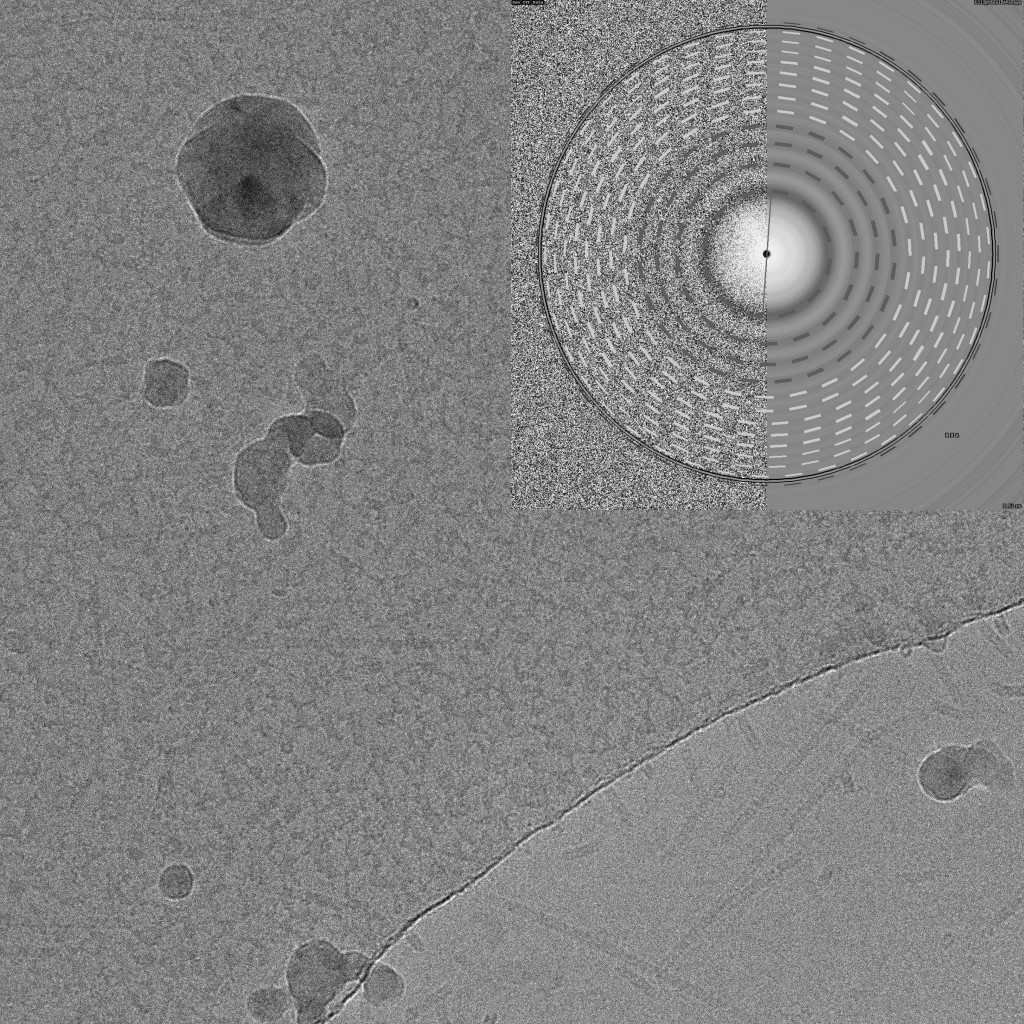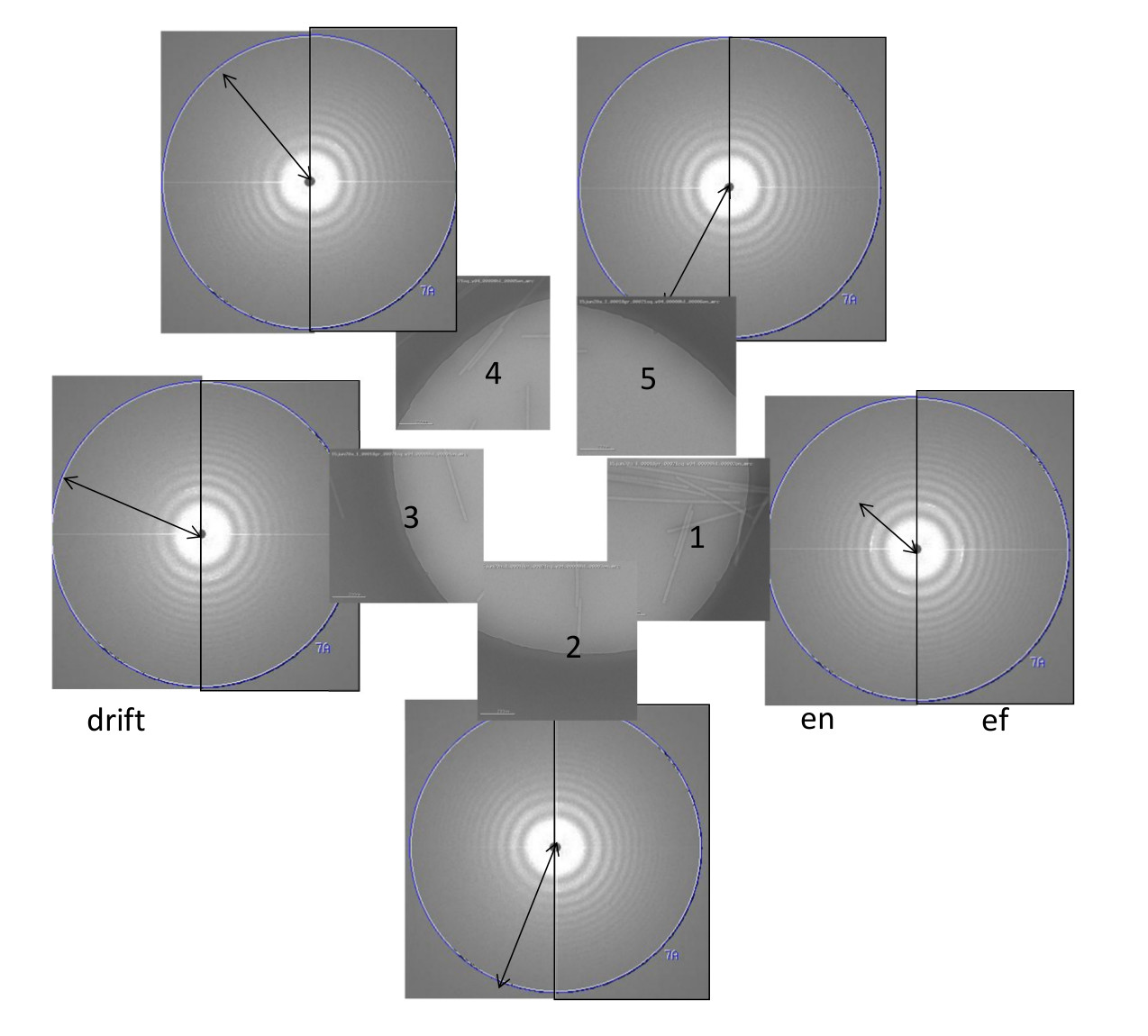Image/sample motion during first exposure
Added by Jason van Rooyen over 10 years ago
Hi all,
I am currently "recomissioning" our leginon-automated F20 after a move and I have noticed what seems to be drift in the first micrograph of the cryo-EM defocus series.
The problem manifests as what looks like severe drift in the first exposure:
The CTF is much clearer and less astigmatic in the second image:
This occurs for all three exposure targets around the circumference of the quantifoil hole.
I am using the standard MSI-T workflow with a pre-specimen shutter (DM controls the US4000 with both shutters set to closed at idle) and 2.5 s pause before exposure acquisition. The drift monitor is running and set to allow exposure when dropping below 4 A/s.
So far, I have tried:
- Setting both defocii to the same value.
- Swapping the preset order but it's still the first one that suffers the phenomenon.
- Increasing the wait time to 30 seconds before exposure acquisition.
Unfortunately, none of these have solved or revealed the origin of the problem.
Is this simply a charging artefact and unavoidable or could something more sinister and systematic be at play? I worry that there is some hysteresis or issues causing instability after the image shift to the exposure target.
Have you ever encountered a similar problem?
As always, your help and advice is much appreciated.
Thanks,
Jason
Replies (5)
RE: Image/sample motion during first exposure - Added by Anchi Cheng over 10 years ago
We have observed the same for a while but could not find a software/hardware reason for it. The same is observed when moving with iterative stage movement to the multiple targets selected on an hl image. Even after the drift monitor result of the focus target declares an insignificant drift, the first exposure image would move more at first (based on drift tracking in movie-capable camera, and found in the first two frames, but more pronouced in the first 200 ms frame) than subsequent frames and more than the first two frames of the later exposure within the same parent image.
Do you have data that says this was not the case previously ?
RE: Image/sample motion during first exposure - Added by Jason van Rooyen over 10 years ago
I have conducted some more tests to (A) see if the drift is reproducible and (B) to find the source:
I switched to using a test grid of negative stain TMV on continuous carbon-coated quantifoil. Dose was around 20e/A^2 and exposure time around 700 ms. Drift monitoring was set to a limit of 4A/s.
The drift is present in the first exposure (2 defocii series but both set to 3.5um) in several exposure positions:
I then tested 5 position exposures with 2 defocii (both set at 3.5 um):
Again, you can see the drift in some of the first exposures but not the second.
I also tried a series of exposure targets where exposures of carbon edges alternated with exposures of pure carbon regions. The drift was only present in the edge images.
Exposures in the centre of the hole also gave no discernible drift.
My conclusions so far are that:
*The drift only occurs when an edge is present.
*The drift only occurs in the first exposure.
*The magnitude of drift seems correlated with the amount of carbon in the frame.
*The direction of drift seems to be perpendicular to the edge.
I will be modifying my cryo collection strategy to avoid carbon edges in future but it's going to make CTF determination and real-time data quality assessments more difficult.
RE: Image/sample motion during first exposure - Added by Anchi Cheng over 10 years ago
This appears to get into the area of beam induced movement and/or charging. Your observation is interesting because I often hear people say that a bit of carbon in the beam (not necessary in the camera image) is one way to minimize charging. As long as you intend to take multiple exposures in a hole, it is most likely that some carbon would be in the beam.
On the other hand, there are reports that the best way to minimize beam-induced movement is to illuminate the hole in such a way carbon in all directions touches the beam. For example, our highest resolution data are now taken with smaller c-flat hole (1.2 um) and only one image is taken per hole to follow this guideline.
RE: Image/sample motion during first exposure - Added by Jason van Rooyen over 10 years ago
That makes sense, thanks Anchi.
If I am going to avoid carbon then I will need to determine CTFs from particles. Is there a way in Appion to calculate CTFs from stacks of boxed particles?
I know it used to be possible in AceMan but that required MATLAB.
If not, I will try write a python script to take exported EMAN box files and determine the CTFs in EMAN.
Thanks,
Jason
RE: Image/sample motion during first exposure - Added by Anchi Cheng over 10 years ago
Jason,
I asked around and no, current Appion does not calculate CTFs from stacks of boxed particles.